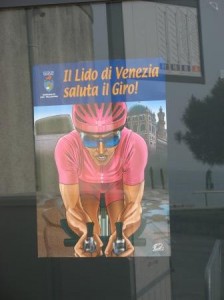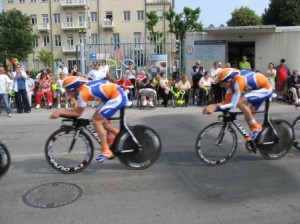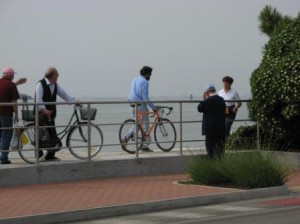I regret that this report was held up by technical traffic backed up over my computer. But I promised a report on the effect of stage one of the Giro d’Italia on the Lido, so here it is. Note to self: Don’t be so quick to make promises.

I think the impact of this event was mitigated, not by a resurgence of civic pride — the wildness that bursts forth when, say, Italy wins the World Cup — but by the wealth of stuff that was on sale. Violent pink being the official color of the winner’s jersey (as crocus yellow is for the Tour de France), the crowds were speckled with pink baseball caps, T-shirts, rubber bracelets, and other paraphernalia.
We took the special boat from Venice to the Lido and got off at San Camillo, the rehabilitation hospital, to visit Lino’s oldest sister who’s been there for a month for problems I don’t understand (polite way of saying “Didn’t ask, didn’t listen”), related generally to her being past 90. We took her outside and sat by the edge of the road with a batch of other inmates and watched the squads shoot past. 
No more than five minutes after the last team whizzed by, the army of Giro workers passed, tearing down their signs and collecting the plastic cones in the street and all the temporary metal barriers. That was much more impressive than the race itself, perhaps because it was so dazzlingly efficient.
We were favored with a rare sighting of the Mayor of Venice, Massimo Cacciari, who passed by with his bike and his characteristic nonchalance, an attitude of pretending the rest of the world, primarily its humans, doesn’t exist. (“It’s him,” “It’s him,” the people on our side of the road were murmuring excitedly, as if they’d managed to glimpse the last great auk.) Being a professor of philosophy, whose Ph.D thesis was on Immanuel Kant’s “Critique of Judgment,” he might have been giving us a demonstration of Kant’s approach toward the problem of the other six billion people on earth: Walk away.
I realize it was his day off, even though I wouldn’t have thought that politicians gave themselves time off when they go out to move among the voters. But scorn is his default position; 
Years ago I interviewed him for 30 minutes — everyone was so impressed that he gave me a whole 30 minutes! — and he didn’t let me ask one question. I realize now that instead of taking the usual mayoral approach to interviews (I’ve done four by now, anyway), which is to give non-answers, he cut out the whole answer category entirely. What I got was a monologue about the history of Venice, which I already knew and if I hadn’t, could (and should) have read in a book. Interviewing mayors is a bigger waste of time than popping bubblewrap. And less amusing.
